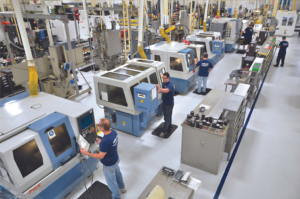CNC machining is a term that’s commonly used in the manufacturing industry. What does it mean, and how does it support the accurate manufacturing of precision tools? Read below.
What Is CNC Machining?
CNC (short for “computer numerical control”) machining is a manufacturing process where automated software controls and machine tools work together to remove material from a workpiece, resulting in a custom part. It’s a subtractive manufacturing method, which means material is removed from the workpiece. This is the main differentiator from other manufacturing methods like 3D printing (additive) and injection molding (formative).
CNC machining can be done to many different materials, like metals (the most common), but also plastics, wood, and even glass. It’s an important process for our team at Moeller, as it’s how we manufacture our standard and custom die components.
What Is a CNC Machine?
A CNC machine is a programmable machine that can autonomously perform CNC machining tasks. In other words, it can cut or change a workpiece material based on the coded, programmed instructions entered into it without a manual operator.
6 Benefits of CNC Machining
CNC machining is a popular manufacturing method for a reason. It brings many advantages to plants and production floors across the globe. Some of the key benefits of CNC machining are:
- Automated processes — CNC machines complete jobs without a manual operator directly controlling them, streamlining processes and reducing labor costs.
- Quick & efficient production — CNC machines are faster than manual machines. Some manual machines that have undergone a CNC retrofit have been proven to produce parts 75-300% faster.
- Accurate & consistent results — For precise, repeatable results, there’s no better choice than CNC machining. Programmed code ensures parts are made accurately every time.
- Minimal material waste — Due to accurate and consistent results, the CNC machining process can significantly reduce material waste.
- Safe operations — Since CNC machines can function autonomously, operators can stand back and stay safe.
- Cost-effective solutions — With reduced labor needs and minimal product errors, CNC machining has proven itself to be one of the most cost-effective manufacturing methods available.
Overview of the CNC Machining Process
The CNC machining process can look a bit different each time, depending on which specific services and operations are needed for a particular application. However, most jobs follow the same four basic stages, which are listed and explained below.
Stage 1: CAD Model Design
CAD (computer-aided design) is the process of using computer software to create, modify, analyze, or optimize a design. It replaced manual drafting.
That said, this step of the CNC machining process involves a designer creating blueprints for a component using CAD. Since it’s a draft, they’ll include tolerances, which are acceptable ranges of dimensional variation that would still allow the part to function properly.
Stage 2: CAD File Conversion
During this stage, the designer converts the CAD file using CAM (computer-aided manufacturing) software. This extracts the part’s geometrical characteristics and generates G-code that will control the CNC machine to produce the part in the most efficient way possible.
Stage 3: CNC Machine Setup
From there, the CNC machine is set up for operation. This involves programming the machine with code created in the last stage, then inserting the workpiece material into the machine and attaching any special fixturing for part to part consistency.
Stage 4: CNC Machine Operation
Production starts! The code automates the CNC machine to remove or modify particular layers of workpiece material until the finished product is complete.
6 Common CNC Machining Operations
There are many specific operations that a CNC machine can perform to create a part. Here’s a look at six of the most common, or standard:
- Drilling: uses drill bits to create cylindrical holes in the workpiece material.
- Turning: uses single-point cutting tools to remove material from a rotating workpiece.
- Milling: uses multi-point cutting tools to remove material from a workpiece.
- Jig grinding: specialty grinding process used to make precise holes, slots, pockets, and contours in a workpiece.
- Profile grinding: specialty grinding process used to achieve precise inside and outside diameters of cylindrical parts.
- Wire EDM: short for “electrical discharge machining,” it uses a thin strand of wire and de-ionized water to conduct electricity and allow the wire to cut through the workpiece, using the heat from electrical sparks.
CNC Machining Services at Moeller Precision Tool
At Moeller Precision Tool, we’re familiar with all of the CNC machining processes and services listed above. Every day, we use advanced CNC machining techniques to produce standard and special die components for metal stamping applications. We also have a climate-controlled inspection department with CMM (coordinate measuring machine) equipment, SPC (statistical process control) equipment, and quality control certification experts.
We’re committed to being the most technologically advanced in the industry, offering modern capabilities that are proven to deliver high-quality results. Some of our main CNC machining capabilities include:
- Wire EDM
- Multi-axis
- Hard turning
- Hard milling
- Turning
- Milling
- High-speed milling
- Jig grinding
- Profile grinding
Moeller is always looking for ways to expand and improve those capabilities to better serve our customers. If we don’t already have a solution for what you need, we’re happy to either figure one out or direct you to one of our partners that can service you better.
For Quality, CNC-Machined Die Components, Contact Moeller Precision Tool.
Want to learn more about how our advanced CNC machining capabilities can benefit your metal stamping application? We’d love to talk. Contact our team online today.



